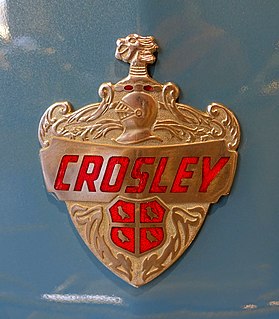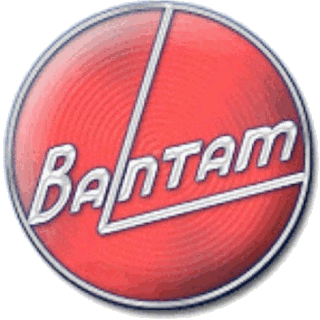
Hummer is a brand of pickups and SUVs that was first marketed in 1992 when AM General began selling a civilian version of the M998 Humvee. Although discontinued in 2010, Hummer returned as a sub-brand of GMC in 2020. In 1998, General Motors (GM) purchased the brand name from AM General and marketed three vehicles: the original Hummer H1, based on the military Humvee, as well as the new H2 and H3 models that were based on smaller, civilian-market GM platforms.

MG is a British automotive marque founded by Cecil Kimber in the 1920s, and M.G. Car Company Limited was the British sports car manufacturer that made the marque famous. Best known for its open two-seater sports cars, MG also produced saloons and coupés, with engines up to three litres in size. The marque is now owned by state-owned Chinese company SAIC Motor Corporation Limited.

MG Rover Group was the last domestically owned mass-production car manufacturer in the British motor industry. The company was formed when BMW sold the car-making and engine manufacturing assets of the original Rover Group to the Phoenix Consortium in 2000.

The Austin Motor Company Limited was a British manufacturer of motor vehicles, founded in 1905 by Herbert Austin. In 1952 it was merged with Morris Motors Limited in the new holding company British Motor Corporation (BMC) Limited, keeping its separate identity. The marque Austin was used until 1987. The trademark is currently owned by the Chinese firm SAIC Motor, after being transferred from bankrupt subsidiary Nanjing Automotive which had acquired it with MG Rover Group in July 2005.
Austin-Healey was a British sports car maker established in 1952 through a joint venture between the Austin division of the British Motor Corporation (BMC) and the Donald Healey Motor Company (Healey), a renowned automotive engineering and design firm. Leonard Lord represented BMC and Donald Healey his firm.
Midway Games Inc., known variously as Midway Manufacturing and Bally Midway, and commonly known as simply Midway, was an American video game developer and publisher. Midway's franchises included Mortal Kombat, Rampage, Spy Hunter, NBA Jam, Cruis'n, and NFL Blitz. Midway also acquired the rights to video games that were originally developed by Williams Electronics and Atari Games, such as Defender, Joust, Robotron 2084, Gauntlet, and the Rush series.

Crosley was a small, independent American manufacturer of subcompact cars, bordering on microcars. At first called the Crosley Corporation and later Crosley Motors Incorporated, the Cincinnati, Ohio, firm was active from 1939 to 1952, interrupted by World War II production. Their station wagons were the most popular model, but also offered were sedans, pickups, convertibles, a sports car, and even a tiny jeep-like vehicle. For export, the cars were badged Crosmobile.

The American Bantam Car Company was an American automobile manufacturing company incorporated in the state of Pennsylvania. American Bantam is credited with the invention of the Original Jeep in 1940. The company's founders, Roy Evans and William A. Ward, Jr., combined resources to purchase the assets of the bankrupt American Austin Car Company in August of 1935 during liquidation. In 1935 the new company produced vehicles based on the American Austin tooling, operating as Evans Operations Inc. The new company was incorporated as American Bantam Car Company in June 1936. The new company launched a public fundraising campaign and redesigned their entire vehicle line to launch a completely refreshed selection of American Bantam roadsters and delivery vans in 1937. The company continued to manufacture vehicles well into 1943, until all of its manufacturing efforts were focused on World War II weapons production, including the manufacture of torpedo engines, aircraft controls and parts, torpedo tail gearing, amphibious trailers and cargo trailers.

Singer Motors Limited was a British motor vehicle manufacturing business, originally a bicycle manufacturer founded as Singer & Co by George Singer, in 1874 in Coventry, England. Singer & Co's bicycle manufacture continued. From 1901 George Singer's Singer Motor Co made cars and commercial vehicles.

The Saturn Sky is a roadster that was produced by Saturn, and was initially released in the first quarter of 2006 as a 2007 model. It uses the Kappa automobile platform shared with the Pontiac Solstice. The Sky concept was shown at the 2005 North American International Auto Show, with the production version following at the 2006 show. It was built at GM's Wilmington Assembly plant in Wilmington, Delaware, alongside the Solstice. The Sky featured 18-inch (457 mm) wheels and a 2.4 L Ecotec LE5 I4 engine that produced 177 hp (132 kW), a new straight-4 2.0 L turbocharged direct injected engine that made 260 hp (194 kW) as well as an optional dealer-installed turbo upgrade kit that made 290 hp (216 kW). Both five-speed manual and automatic transmissions were available.
The Continental De Vaux was an automobile produced by the Continental-De Vaux Company in Grand Rapids, Michigan.

The Ford Model Y is an automobile that was produced by Ford Britain, Ford SAF and Ford Germany from 1932 to 1937. It was the first Ford automobile specifically designed for markets outside the United States, replacing the Model A in Europe.

The Austin 7 is an economy car that was produced from 1923 until 1939 in the United Kingdom by Austin. It was nicknamed the "Baby Austin" and was at that time one of the most popular cars produced for the British market and sold well abroad. Its effect on the British market was similar to that of the Model T Ford in the US, replacing most other British economy cars and cyclecars of the early 1920s. It was also licensed and copied by companies all over the world. The first BMW car, the BMW Dixi, was a licensed Austin 7. In France they were made and sold as Rosengarts, and in the United States they were built by the American Austin Car Company. In Japan, Nissan also used the 7 design as the basis for their first cars, although not under licence. This eventually led to a 1952 agreement for Nissan to build and sell Austins in Japan under the Austin name.

The S800 is a sports car from Honda. Introduced at the 1965 Tokyo Motor Show, the S800 replaced the successful Honda S600 as the company's image car. With a redline of 9,500 rpm, it is one of the highest revving production sports car. The S800 competed with the Austin-Healey Sprite, MG Midget, Triumph Spitfire and Fiat 850 Spider.

The Marion was an automobile produced by the Marion Motor Car Company in Indianapolis, Indiana from 1904 to 1915.

The Tesla Roadster is a battery electric vehicle (BEV) sports car, based on the Lotus Elise chassis, that was produced by the electric car firm Tesla Motors in California from 2008 to 2012. The Roadster was the first highway legal serial production all-electric car to use lithium-ion battery cells and the first production all-electric car to travel more than 320 kilometres (200 mi) per charge. It is also the first production car to be launched into deep space, carried by a Falcon Heavy rocket in a test flight on February 6, 2018.

The Fal-Car, originally known as A Car Without A Name, was an American automobile manufactured from 1909 until 1914 by a company that identified itself in advertisements only as Department C, 19 North May Street, Chicago. The address had previously been the location where the Reliable-Dayton automobile had been built. It was advertised as "trim, classy, speedy and efficient".

Daniels Motor Company was a pioneer brass era American automobile company, founded in 1915 by George E. Daniels with Neff E. Parish. George Daniels was a known lawyer, engineer, and mechanic. He was considered the best motorcar designer in the United States. Neff Parish had his own automobile parts and framing manufacturing company. Neff was the creator of the time's highest-grade heat-treated alloy steel frames, respected in the steel industry. Daniels Motor Company produced 1,500 high quality automobiles between 1916-1924, branding themselves as “the distinguished car with just a little more power than you will ever need”, and “The aristocrat of American cars”.

The BMW i8 is a plug-in hybrid sports car developed by BMW. The i8 was part of BMW's electrified fleet and was marketed under the BMW i sub-brand. The production version of the BMW i8 was unveiled at the 2013 Frankfurt Motor Show and was released in Germany in June 2014. Deliveries to retail customers in the U.S. began in August 2014. A roadster variant was launched in May 2018. Production ended in June 2020.

Willys was a brand name used by Willys–Overland Motors, an American automobile company, founded by John North Willys. It was best known for its design and production of World War II era and later military jeeps (MBs), as well as civilian versions, and branding the 'jeep' military slang-word into the '(Universal) Jeep' marque.


















